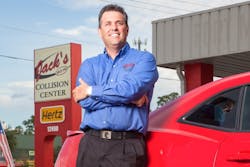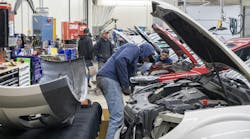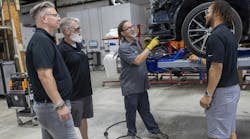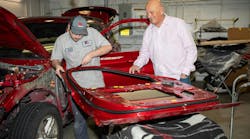Finding Time for the Customer
Kevin Lipscomb was out to dinner in a Fort Myers, Fla., restaurant—not far from Jack’s Collision Center, the shop he and his father owned—when he ran into a former customer, one he remembered well.
This used to be one of his favorite parts of the job. It was one of the aspects of being a shop owner that made the long hours and the obsessive attention to detail all worth while. After all, since opening the shop in 1990, Lipscomb’s entire business was predicated on customer service. The shop’s growth, he says, was entirely based on a foundation of referrals.
So, he enjoyed when he had the chance for an occasional pat on the back. This time around, though, it’d be more like a slap in the face.
“I told him it was great to see him, asked how his car was and joked about how we haven’t seen him in [the shop] for a while,” Lipscomb recalls. “He said, ‘Yeah, that’s because you guys were too busy for me.’ He said he came in two or three times with some family and friends that needed some help with their vehicles and [both my dad and I] were always too busy to see him. He thought we must’ve been ‘too big time’ for him and didn’t care.”
This was April 2009, while Jack’s Collision was in the midst of its worst year in company history. And although the customer’s reasoning was wrong, Lipscomb says his assessment was likely spot on: He and his father rarely had time to greet or talk face-to-face with customers.
The business was deflated due in large part to the absolute collapse of the Florida Gulf Coast economy. In 2006, Jack’s did $2.8 million in sales. In 2009, it did just $1.7 million.
“That night in the restaurant was a wake-up call,” Lipscomb says. “It was easy to sit around and point to the economy and point to everyone else who was doing worse. But, that customer was right on. We were a customer-service company that no longer focused on the customer. If we were going to recover and grow from the recession, that was the only way we could do it—focus on the customer.”
The Backstory
Lipscomb was 19 and halfway through earning a bachelor’s degree when his father, Jack, saw a listing for a body shop in the booming Fort Myers area.
Lipscomb’s childhood was spent in the various collision facilities his dad worked in. He rarely missed a chance to get his hands dirty, and he developed a passion for paint and bodywork early on.
“My dad just said that this was our chance to try it for ourselves,” Lipscomb remembers. “We’d be partners, and I figured we should give it a shot. I love the industry—I love working on cars. It just seemed right.”
And for the next 15 years, everything the Lipscombs did went right.'
Their ownership coincided with major growth in the area. The population increased, and the housing market was as strong as it had ever been.
And the shop benefited. Lipscomb says by the early 2000s, the shop had grown from a small, five-employee outfit—and that included Lipscomb, his father and his mother, who served as the secretary—into an 18-person, 18,000-square-foot business.
“Our growth was all organic; it was us being really personable and interacting with customers, building trust, getting referrals, and slowly getting more and more work,” he says.
The Problem
Both Lipscomb and his father are tireless workers, something that served them well in getting the shop off the ground and building its reputation in the area.
As the shop continued to grow, though, their work ethic started to hinder the company.
In the three years preceding the company’s record year in 2006, the shop was overloaded with jobs.
“The [Fort Myers] area was just full of money at the time; everyone had money to spend,” Lipscomb says. “We never worried about getting cars in. We basically became order takers, and we just put down our heads and tried to plow through the work.”
The company topped out in 2006, nearly reaching $3 million in total sales and working on more than 250 cars each month. The staff in back was more or less sufficient for the workload—that is, if it had any support up front.
Through the growth, Lipscomb says he chose not to expand the front office staff. He had one other estimator besides himself and his father. That was it, and it caused Lipscomb and his father to take on nearly every managerial responsibility in the company. His father handled the finances—all the accounting, taxes, etc.—and Lipscomb wrote estimates, ordered parts, managed the parts department, oversaw shop operations, and personally performed quality control (QC) inspections on each and every job done by his technicians, down to each weld on each vehicle.
“It was obsessive; I was so concerned and worried about quality that I didn’t trust anyone,” he says. “And we were getting into DRP agreements and generating so many large clients, I had to handle those accounts.”
The ever-increasing workload forced him and his father to essentially be “untouchable” for customers in the shop, he says. They simply didn’t have the time. The shop was so busy, though, it didn’t seem to have an effect, Lipscomb says.
Then, the economy crashed in 2008, and the shop’s sales quickly plummeted.
The Solution
The Gulf Coast was in serious financial hardship in 2009, Lipscomb says. The real estate market collapsed; homes that were worth $500,000 two years prior could now barely get $150,000 in quick sales. Many lost their homes. Even more lost their jobs.
Suddenly, Jack’s Collision Center had to worry about filling its bays for the first time since it opened its doors.
After Lipscomb’s customer confrontation while out to dinner that April, he knew the key to a resurgence would be focusing on the exact same customer-oriented principles that helped the business grow initially.
The only problem was that the shop’s staffing and his and his father’s enormous levels of responsibility made that impossible.
“All along I kept deciding not to hire people,” he says. “I would look at it and say, ‘Five hundred bucks a week for someone to be in charge of parts? Well, I can do that myself and we’ll save that money.’ But then I started to realize that the amount of time I lost doing that job, and the effect it had on everyone else’s productivity, was costing us far more than the money for a salary.”
Lipscomb took the time to crunch the numbers—how much money was needed for important new positions. He looked at the possible returns—how it would shift the ability to serve customers, increase his shop’s efficiency, increase cycle time, and, hopefully, improve sales.
Satisfied, he took the calculated risk and started adding staff. First, he started with a parts manager. Then he brought on what he calls a “team manager” that oversees operations in the shop. Then it was an additional estimator, and someone dedicated to greeting customers at the front desk.
With each hire, he saw a quick jump in efficiency, as he got out of his staff’s way and began focusing on “bigger-picture things,” like completely overhauling customer-interaction procedures.
The first changes dealt with operation-oriented aspects. His staff began washing each vehicle, even if “it came in just to get a light bulb changed.” With more help up front, they put a larger emphasis on updating customers throughout the repair process, asking them at drop-off what their preferred method of contact is and how often they’d like to be contacted.
Each employee has a defined role in this process, which allows everyone to give the correct amount of attention to each task, Lipscomb says.
“It took me more than 25 years, but I finally learned that you need to put people in positions to do what they do best, and trust them to do it,” he says.
The Aftermath
The business’s growth wasn’t immediate, but the shop was able to stabilize itself in 2010, enough for Lipscomb and his father to move the company into a “modern” facility a few blocks away on a better road. The new shop opened in December of 2012.
In 2013, with its 22-person staff and new facility fully operational, Jack’s Collision Center topped $2.4 million in sales. Productivity among technicians is at an all-time high, Lipscomb says, averaging above 150 percent as a team, and the shop is back above the 200-car mark each month.
For his part, Lipscomb has rededicated himself to focusing on his customers. He makes himself available to every customer when they need him, even giving out his email and cell phone number. He also personally makes a day-after-delivery, follow-up phone call to each customer thanking them for their service and asking if there was anything he or his staff could’ve done better.
The effect, he says, is pretty evident. The company measures customer survey index scores in a number of ways for its different insurance partners, but in all of its direct repair programs (DRP), Jack’s measures out impressively. Lipscomb says the shop is in the top-10 for the south region of Allstate’s program. It’s No. 1 for Progressive.
The Takeaway
No one wants to have to come to a collision facility, Lipscomb says. “It’s not like they can leave, and they’ll be like, ‘See you next Wednesday.’”
“It might be years before they need you again,” he says. “They never want to have an accident again. But hopefully we give them the treatment that if anything happens to them, or their friends or their family, they say, ‘You have to go to Jack’s.’
“That has to be the goal, and that’s what we have to focus on. You need the time to do it, though. If we hadn’t made the changes we did, we still wouldn’t have the time. That time you get from [delegating] is going to pay in productivity, and it’s going to be the difference in success or failure for the shop.”




